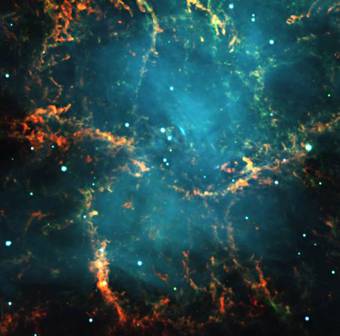Unexpected findings on the production of elements
2015-01-27 – News from Physik-Department

The lifetime of massive stars end with a supernova. The star explodes and briefly lights up as bright as a whole galaxy. In such an explosion the heavier chemical elements such as silver, tin and iodine are produced and distributed throughout the space between stars. Small amounts of debris from these distant explosions fall on Earth as it travels through the galaxy and are eventually deposited on the seabed. Only a few years ago, Physicists from Physik-Department succeeded in detecting the stable iron isotope 60Fe in deep-sea manganese crusts, which can be assumed with certainty to originate from supernovae. Now, a team of researchers from the University of Vienna, the TU München, the Australian National University, Canberra, and the Hebrew University, Israel, analysed samples from the seabed on interstellar plutonium and gained a new understanding of the origin of heavy elements.
The researchers investigated deep-sea sediments from the Pacific Ocean, including a 10-inch-thick Ferrum-Manganese-Crust from a depth of 5000 meters. This 25 million year old deposit contained, among trace elements from the ocean, elements of interstellar dust, as showed the following analysis at the accelerator facility Vera in Vienna. The physicists were in search for an isotope of plutonium, plutonium-244, which does not occur naturally on Earth, and, with a half-life of 81 million years, is an important marker for traces of stellar explosions in recent Earth history. Supernova explosions also produce lead, gold and mercury. However, these elements are stable and abundant on earth and therefore not suitable as supernova tracers.
“Surprisingly, we found much less plutonium than expected,” says Dr. Thomas Faestermann from the TU München, who, just like Dr. Gunther Korschinek, contributed to the new findings. Because of the frequency of supernovae, the scientists had expected much more plutonium-244 in the marine sample. On average, there are about one to two supernova explosions per hundred years in our galaxy. However, the samples contained only a much smaller fraction of plutonium than was expected due to the frequency of supernovae.
Rare cosmic explosions as a solution?
The researchers conclude that the plutonium may not be formed in standard supernovae at all. They suggest that it may require rarer and more explosive events such as the merging of two neutron stars to make them.
- Desk
- Petra Riedel, Dr. Johannes Wiedersich
Publication
Contact
- Dr. Gunther Korschinek
- Physik Department E15Technische Universität MünchenJames-Franck-Str. 185748 GarchingGermanyTel: +49 89 289-14257e-mail: korschin@tum.de
- Dr. Thomas Faestermann
- Physik Department E12Technische Universität MünchenJames-Franck-Str. 185748 GarchingGermanyTel: +49 89 289-12438e-mail: thomas.faestermann@mytum.de
- Prof. Dr. Anton Wallner
Links
- Excellence Cluster Universe
- Dr. Gunter Korschinek: Research group Experimentelle Astroteilchenphysik
- Dr. Thomas Faestermann: Research group Physik der Hadronen und Kerne
- News at the Universität Wien (in German)